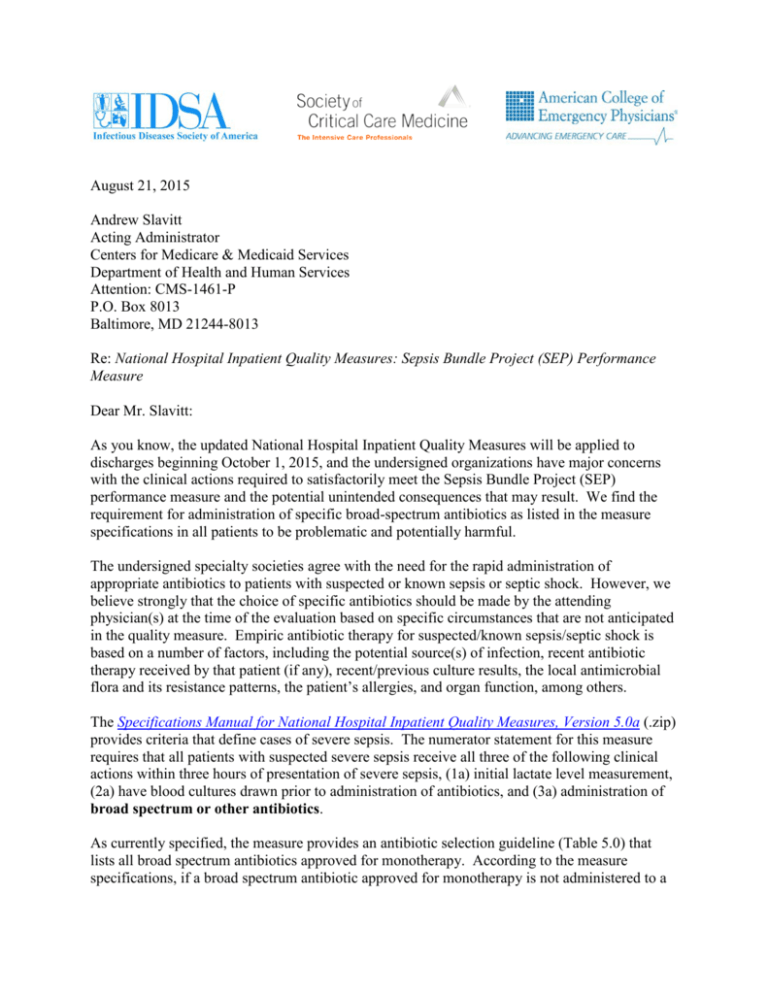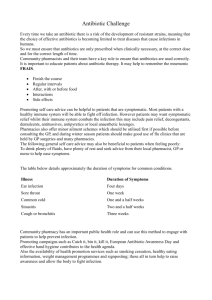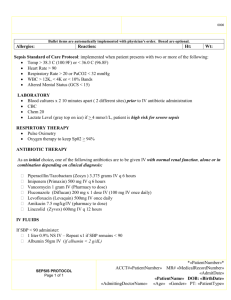Sepsis Bundle Project (SEP)
advertisement

August 21, 2015 Andrew Slavitt Acting Administrator Centers for Medicare & Medicaid Services Department of Health and Human Services Attention: CMS-1461-P P.O. Box 8013 Baltimore, MD 21244-8013 Re: National Hospital Inpatient Quality Measures: Sepsis Bundle Project (SEP) Performance Measure Dear Mr. Slavitt: As you know, the updated National Hospital Inpatient Quality Measures will be applied to discharges beginning October 1, 2015, and the undersigned organizations have major concerns with the clinical actions required to satisfactorily meet the Sepsis Bundle Project (SEP) performance measure and the potential unintended consequences that may result. We find the requirement for administration of specific broad-spectrum antibiotics as listed in the measure specifications in all patients to be problematic and potentially harmful. The undersigned specialty societies agree with the need for the rapid administration of appropriate antibiotics to patients with suspected or known sepsis or septic shock. However, we believe strongly that the choice of specific antibiotics should be made by the attending physician(s) at the time of the evaluation based on specific circumstances that are not anticipated in the quality measure. Empiric antibiotic therapy for suspected/known sepsis/septic shock is based on a number of factors, including the potential source(s) of infection, recent antibiotic therapy received by that patient (if any), recent/previous culture results, the local antimicrobial flora and its resistance patterns, the patient’s allergies, and organ function, among others. The Specifications Manual for National Hospital Inpatient Quality Measures, Version 5.0a (.zip) provides criteria that define cases of severe sepsis. The numerator statement for this measure requires that all patients with suspected severe sepsis receive all three of the following clinical actions within three hours of presentation of severe sepsis, (1a) initial lactate level measurement, (2a) have blood cultures drawn prior to administration of antibiotics, and (3a) administration of broad spectrum or other antibiotics. As currently specified, the measure provides an antibiotic selection guideline (Table 5.0) that lists all broad spectrum antibiotics approved for monotherapy. According to the measure specifications, if a broad spectrum antibiotic approved for monotherapy is not administered to a patient with severe sepsis within three hours of presentation, then a medical practitioner must consult the “Combination Antibiotic Therapy Table” to administer an approved antibiotic drug combination to satisfactorily meet the measure. We are concerned with the potential unintended consequences that may result due to the required administration of specific listed broad-spectrum antibiotics to severe sepsis patients who present with a known infection that responds better to an antibiotic or antibiotics not in the tables. Patients with severe sepsis or septic shock warrant broad-spectrum therapy until the causative organism and its antimicrobial susceptibilities are defined. However, if the pathogen is known, then targeted pathogen specific therapy is appropriate and often more efficacious. In cases where the source of infection and susceptibilities are apparent, a narrow-spectrum, pathogenspecific antibiotic is more appropriate and use of broad-spectrum antibiotics conflicts with the principles of antibiotic stewardship, which promote the judicious use of antibiotics and limits unnecessary exposure to patients. The SEP measure does not allow for administration of narrow-spectrum antibiotics when those would be equally or more efficacious, and due to the pressures of avoiding payment penalties, medical practitioners would be inappropriately administering broad-spectrum antibiotics to patients with a known source of infection to satisfactorily comply with the SEP measure. Inappropriate antibiotic prescribing behaviors have led to the marked increase of antibiotic resistant bacteria and have negatively impacted patient mortality with conditions such as Clostridium difficile infection. Additionally, the prescriptive list of approved antibiotics does not promote best practices as physicians may use suboptimal correlates specified within the antibiotic selection guideline to treat infections more susceptible to an antibiotic not approved for the SEP measure. In the interest of patient safety, we respectfully recommend that the measure be modified to allow a physician to document the prescribing of a more appropriate, targeted antibiotic when the source of infection is apparent and to indicate this by way of a progress note in the record. This would require additional instructions in the specification manual to allow chart abstractors to account for these cases. We believe this to be the most expedient remedy to avoid unintended consequences and allow for best practices in prescribing the appropriate antibiotic therapy for specific situations according to the physician’s expertise. We make this recommendation in light of the CY2016 IQR Program start date of October 1, 2015. We appreciate the efforts of CMS to promote improved patient safety and better quality of care as set forth in the National Hospital Inpatient Quality Measures. We welcome further discussion with CMS and other stakeholders on this matter related to the SEP measure. If you have any questions, please feel free to contact Andrés Rodríguez, Director for Practice & Payment Policy, IDSA at 703-299-5146 or arodriguez@idsociety.org. Sincerely, Stephen B. Calderwood, MD, FIDSA President, IDSA Craig M. Coopersmith, MD, FCCM President, SCCM Michael J. Gerardi, MD, FAAP, FACEP President, ACEP Cc: Kate Goodrich, MD, MHS - Director, Quality Measurement and Value-based Incentives Group, Center for Clinical Standards & Quality, Centers for Medicare & Medicaid Services







